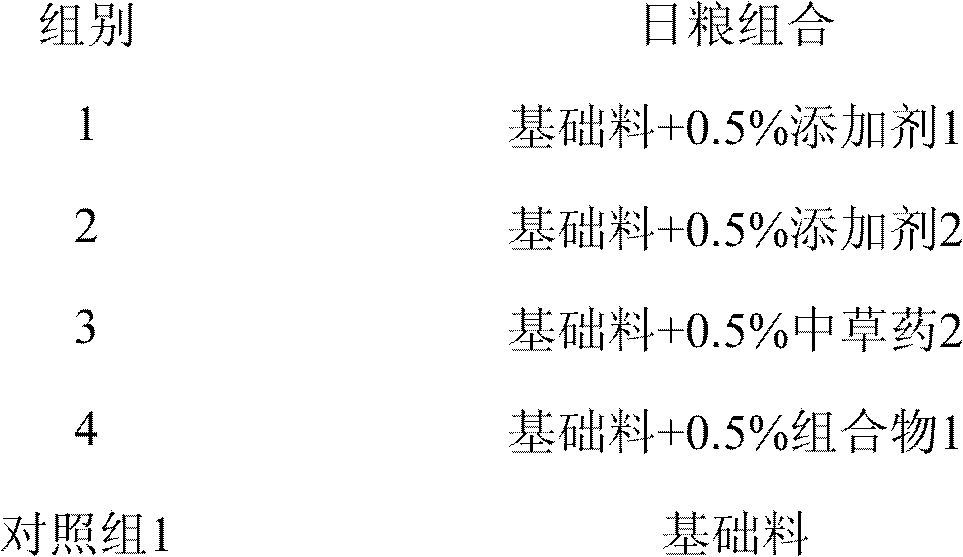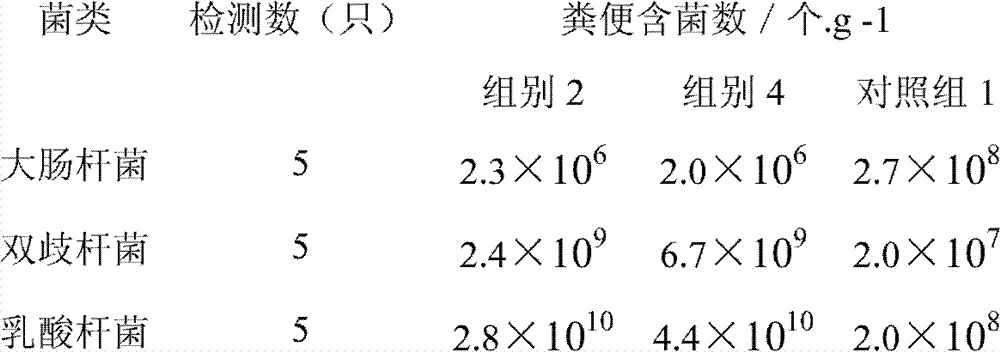Chinese herbal medicine micro-ecological synbiotic feed addictive, preparation method and application thereof
A technology of Chinese herbal medicine additives and feed additives, which is applied in the field of animal husbandry, can solve the problems of Lactobacillus heat resistance and Bacillus subtilis not producing lactic acid, etc., to reduce feeding costs, benefit human health and environmental protection, and promote pancreatic secretion Effect
- Summary
- Abstract
- Description
- Claims
- Application Information
AI Technical Summary
Problems solved by technology
Method used
Image
Examples
Embodiment 1
[0030] The preparation of embodiment 1 Chinese herbal medicine microecological synbiotics feed additive
[0031] 1. Weigh the oligosaccharides as each 10Kg of fructooligosaccharides, xylooligosaccharides, isomaltooligosaccharides and soybean oligosaccharides;
[0032] Two, the preparation of lactic acid bacillus preparation:
[0033] Bacterial kind is the lactic acid bacillus (lactic acid bacillus) of freeze-drying preservation; The lactic acid bacillus culture medium I weight part is made up of the following components: 0.5 part of peptone, 0.3 part of beef extract, 0.1 part of yeast extract, 0.5 part of sodium chloride parts, MnSO 4 part.H 2 O 0.005 parts, CaCl 2 0.00756 parts, MgSO 4 .7H 2 0.05 parts of O, 100 parts of ultrapure water, pH 6.8, sterilized by high-pressure steam at 115°C for 30 minutes;
[0034] ① Expand the seed fungus, take the fungus on the slope (such as an inoculation loop) and inoculate it into a test tube containing Lactobacillus culture medium, ...
Embodiment 2
[0049] The feeding effect of embodiment 2 meat rabbit
[0050] Sixty 60-day-old meat rabbits were selected for the experiment, and were randomly divided into 6 treatment groups according to sex and body weight. Each group had 2 replicates, and each replicate had 5 meat rabbits. The test period was 5 weeks. The diet combinations of each group are shown in Table 4.
[0051] Table 1 Experimental grouping and diet combination
[0052]
[0053] Described base material is the conventional meat rabbit feed of market sale; Above-mentioned percentage is percentage by weight
[0054] Table 2 Effects of different combinations and dosages on the performance of meat rabbits (g)
[0055]
[0056] Note: The data adopts the mean ± standard deviation; the numbers on the same line are marked with * and **, indicating that there are significant differences at the level of 0.05 and 0.01.
[0057] It can be seen from Table 2 that at the age of 60-95 days, the daily gain, feed intake and f...
Embodiment 3
[0061] The feeding effect of embodiment 3 fur rabbit
[0062] Sixty 60-day-old woolly rabbits were selected for the experiment, and were randomly divided into 6 treatment groups according to sex and body weight. Each group had 2 replicates, and each replicate had 5 meat rabbits. The test period was 5 weeks. The diet combinations of each group are shown in Table 5.
[0063] Table 4 Experimental grouping and diet combination
[0064]
[0065] The above percentages are percentages by weight
[0066] Table 5 Effects of different combinations and dosages on the performance of woolly rabbits (g)
[0067]
[0068] Note: The data adopts the mean ± standard deviation; the numbers on the same line are marked with * and **, indicating that there are significant differences at the level of 0.05 and 0.01.
[0069] It can be seen from Table 5 that the daily gain, feed intake and feed-to-meat ratio of the wool rabbits in the test group 4 are significantly better than the control gro...
PUM
 Login to View More
Login to View More Abstract
Description
Claims
Application Information
 Login to View More
Login to View More - R&D
- Intellectual Property
- Life Sciences
- Materials
- Tech Scout
- Unparalleled Data Quality
- Higher Quality Content
- 60% Fewer Hallucinations
Browse by: Latest US Patents, China's latest patents, Technical Efficacy Thesaurus, Application Domain, Technology Topic, Popular Technical Reports.
© 2025 PatSnap. All rights reserved.Legal|Privacy policy|Modern Slavery Act Transparency Statement|Sitemap|About US| Contact US: help@patsnap.com



